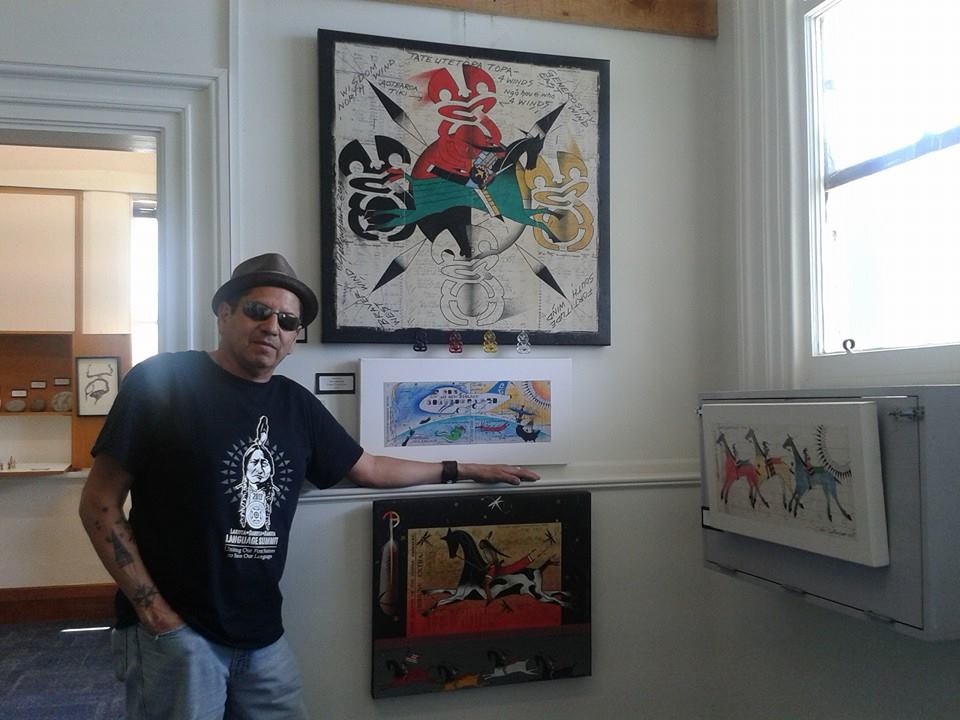
Jim Yellowhawk displaying work locally. Photo from Facebook
Ledger art to honor Maori and Lakota warriorsB
By Richie Richards
Native Sun News Staff Writer RAPID CITY –– The humble spirit of an artist is defined by the gifts they give to others and many circumvent the focus from themselves. An artist gives themselves to others. Jim Yellowhawk (Lakota and Iroquois) grew up on the Cheyenne River Reservation where his path to become an artist was laid by his family. His grandmother Annie Yellowhawk was a teacher of the ancestral ways whose stories were told in her traditional beadwork and his father Jerry Yellowhawk produced art in many forms as well. After graduating with a Bachelor of Science in Art from Marion College in Indiana and studying at the Ohio School of Art and Design, Yellowhawk has been performing Lakota men’s traditional dancing internationally and has opened his art to a world stage. During his travels to New Zealand, his art was recognized by Maori artisans and is now featured in gallery exhibits there locally. Recently, as a widow Jim Yellowhawk has placed an emphasis on “healing” in his work. His wife Ruth passed in 2010 and to honor her he painted a mural at the Eagle Butte Hospital. Like a wandering spirit looking for art to occur so he can record it, Yellowhawk divides his time between the Black Hills of South Dakota, the San Francisco Bay Area, and Golden Bay, New Zealand. It was during a visit to New Zealand in 2010, while attending a conference in Roturua, that Yellowhawk was introduced to the story of Haane Manahi. Manahi was a member of the 28th Maori Battalion who fought during World War II. The story of Haane Manahi is a spiritual journey and cross-cultural lesson of humility which is without borders or ethnic assignment. Like many indigenous nations around the world during times of war, the Maori of New Zealand were asked to fight in WWII and did so with honor despite their relationship with the dominant society. The Maori warriors of ancestral times instilled fear in those opposing their wrath and to this day their descendants carry that spirit of resilience and resistance.

Jim Yellohawk with some of his work in New Zealand. Photo from Facebook
Of the greatest honors of valor and recognition for war-time service in New Zealand and the United Kingdom is the Victoria Cross. It is similar to the Medal of Honor in the United States. Before volunteering for the newly formed Maori Battalion of the New Zealand Military Forces, Manahi worked locally as a laborer. He fought in the Battle of Greece and the Battle of Crete- he was wounded while fighting in Crete. Despite being wounded in the chest, he continued to fight. After recovery from his war-time injury, he returned to the Maori Battalion and saw action in the Western Desert and Tunisian Campaigns. His actions in Takrouna led to a nomination for the Victoria Cross and was supported by four generals. This Victoria Cross nomination was downgraded to an award of Distinguished Conduct Medal. At the time, the Maori were not given the same accolades as their European counterparts. Despite the efforts of his supporters, Haane Manahi did not envy the Victoria Cross medal recognition. His son, Geoffrey, recalled his father saying, “Oh, who cares about the VC, forget it. There were many, many men in the 28th Maori Battalion who could easily have won that Pakeha (white people) medal. Many of them died in the fire of battle.” The medals awarded to Haane Manahi between 1939-1945 include; Distinguished Conduct Medal, 1939-1945 Star, Africa Star with 8th Army, Defence Medal, War Medal 1939-1945, NZ War Service Medal, and a Greek Medal. The things important to Haane’s life were family, fishing and his wife. Haane Manahi died in a car crash in 1986, 21 years before receiving a special citation for bravery posthumously in 2007 by the Queen. Yellowhawk’s Grandfather Bert Yellowhawk was enlisted in the Army and fought in WWII during the same time as Haane Manahi. Listening to this story of Manahi, the Lakota artist wanted to honor both men for their service and their dedication to culture and family. Following that experience of learning of Haane Manahi in 2010, Jim Yellowhawk began his work titled “Blood Warrior.” This ledger painting took two years to complete and is now on display in New Zealand. “Blood Warrior” represents the merging of two cultures on opposite sides of the earth whose history of abject colonial systems, cultural denigration and revival, and the bond of survival through protection of the family, united warriors worlds apart. The depiction in the “Blood Warrior” painting is that of Haane Manahi and Bert Yellowhawk but serves as an honoring of all warriors, men and women, who sacrifice for the people. The text is from his late wife Ruth Yellowhawk. When Native Sun News approached Jim Yellowhawk for an update on his work and information about an upcoming book he illustrated for Joseph Marshall III, this was the article he wanted published. Memorial Day brings responses of all kinds from native peoples who mourn in their own way. This was Jim Yellowhawk’s selfless giving of the focus to the warriors who protect us through the generations. If you would like to see more of Jim Yellowhawk’s work, please visit his website: jimyellowhawk.com or like his Facebook page @ Jim Yellowhawk Art. (Contact Richie Richards at staffwriter@nsweekly.com) Copyright permission Native Sun News
Join the Conversation
